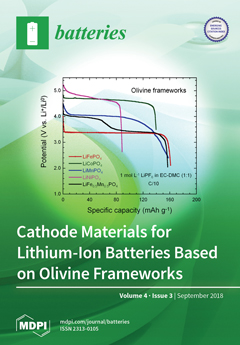La
3+ modification of Na
3V
2(PO
4)
2F
3 was performed by the direct mechanochemically assisted solid-state synthesis of the Na
3V
2−xLa
x(PO
4)
2F
3 compositions, and by the LaPO
4
[...] Read more.
La
3+ modification of Na
3V
2(PO
4)
2F
3 was performed by the direct mechanochemically assisted solid-state synthesis of the Na
3V
2−xLa
x(PO
4)
2F
3 compositions, and by the LaPO
4 coating of the as-prepared Na
3V
2(PO
4)
2F
3 via the precipitation method. It has been shown that no noticeable substitution of the V
3+ ions by the La
3+ ions occurs in the Na
3V
2(PO
4)
2F
3 structure under the synthesis conditions; meanwhile, the introduction of the La
3+ ions into the reagent mixture leads to the formation of the LaPO
4 phase, and accordingly, an increase in the NaF/VPO
4 ratio. The latter results in the formation of the Na
3PO
4 and Na
3VF
6 surface impurity phases, which possess high ionic and electronic conductivity, respectively, and significantly enhances the electrical conductivity and the cycling performance of the composite cathode material both in Na and Li cells, while simple surface modification of Na
3V
2(PO
4)
2F
3 by LaPO
4 via precipitation does not.
Full article





